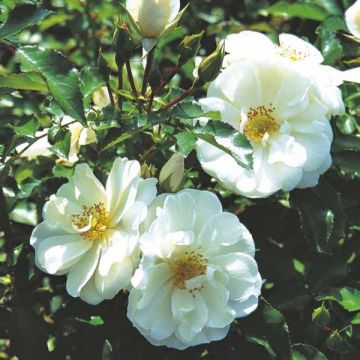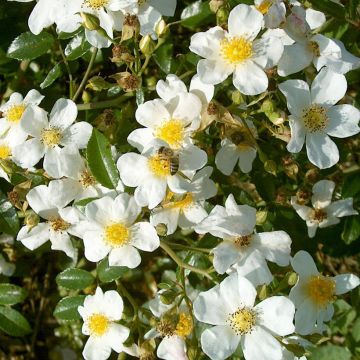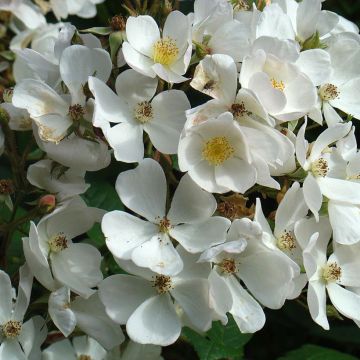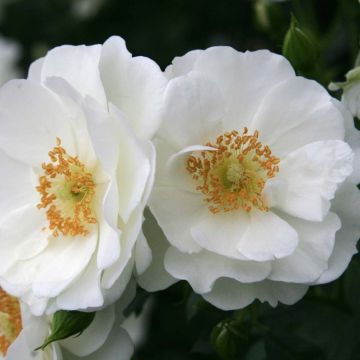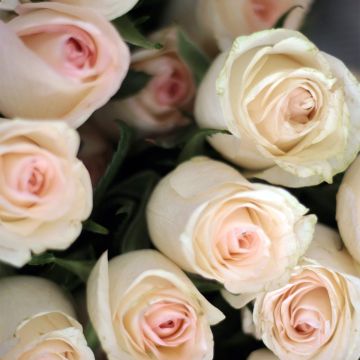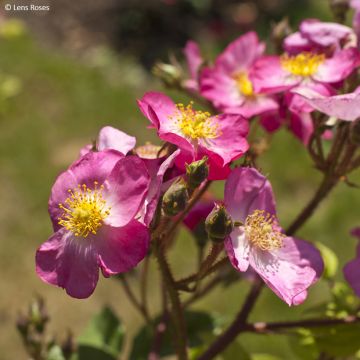

Rosa 'Irene of Denmark' - Polyantha Rose


Rosa 'Irene of Denmark' - Polyantha Rose
Rosa 'Irene of Denmark' - Polyantha Rose
Rosa x polyantha Irene of Denmark
Although it arrived in a kit, with the container on one side, scattered soil in the package, and the rose bush in its own corner, it still managed to recover and grow very quickly." Texte révisé : "Although it arrived in a kit, with the container on one side, scattered soil in the package, and the rose bush in its own corner, it still managed to recover and grow very quickly.
Dominique L., 09/10/2017
Why not try an alternative variety in stock?
View all →This plant carries a 24 months recovery warranty
More information
We guarantee the quality of our plants for a full growing cycle, and will replace at our expense any plant that fails to recover under normal climatic and planting conditions.
From €5.90 for pickup delivery and €6.90 for home delivery
Express home delivery from €8.90.
From €5.90 for pickup delivery and €6.90 for home delivery
Express home delivery from €8.90.
Delivery to Corse prohibited: UE law prohibits the import of this plant from mainland France to Corse as part of the fight against Xylella fastidiosa. Please accept our sincere apologies.
More information

Does this plant fit my garden?
Set up your Plantfit profile →
Description
The 'Irene of Denmark' Rose is a charming modern rose with an old-fashioned style and low but vigorous growth. It is very floriferous and covered with foamy, scented, and white roses from late spring to autumn. Its double flowers, of medium size, are gathered in well-filled bouquets, and their hearts are tinged with a delightful lemon yellow hue, from which a pleasant fragrance emanates. Its flexible habit and elegant small foliage adorn the foreground of flowerbeds and beautifully enhance planters and patios.
The Rosa x polyantha 'Irene of Denmark' flowers, gathered in terminal bouquets, come from the polyantha rose, an old hybrid resulting from Rosa multiflora and Rosa chinensis. The bushy, flexible, and spreading habit of this variety is well-balanced. It will reach approximately 40 cm (16in) in all directions within a few years. The double flowers, 7 cm (3in) in diameter, are full, flat, and slightly scented, with a creamy white colour, revealing a small yellow centre when fully open. They bloom in large numbers in broad pyramidal bouquets from July to October-November, as long as there is no frost. This vigorous variety is fairly disease-resistant if the growing conditions are correct. It develops fine, bright green, deciduous, shiny foliage. Its stems bear thorns.
The 'Irene of Denmark' rose adapts to all soils that are not too dry and all climates, allowing it to be planted almost anywhere. It is perfect mass planted along pathways or to highlight shrub beds. It will integrate perfectly into light or opulent perennial beds. It can be paired with perennial geraniums, campanulas, catmints, or other Stachys. Left to grow freely, it forms a small, romantically shaped flower dome in front of a flowerbed composed of abelias, Kolwitzia, mock oranges, elderberries, or viburnums. It happily overflows from a large pot on the terrace, balcony, or a flower-filled basin composed of nemesias and Diascia.
Poulsen breeding from 1948.
Report an error about the product description
Rosa 'Irene of Denmark' - Polyantha Rose in pictures




Plant habit
Flowering
Foliage
Botanical data
Rosa
x polyantha
Irene of Denmark
Rosaceae
Cultivar or hybrid
Rosa canina Laxa (Wrapped bare root, 2L/3L pot)
Other Roses A to Z
Planting and care
Roses prefer a sunny spot (at least 4 to 5 hours of sunshine a day) but away from the scorching midday sun and strong winds. Roses like loose, permeable, humus-rich soil. They prefer slightly acidic soil, but will get used to any garden as long as the soil is well worked and sufficiently rich. To plant your rosebush in a pot, cultivate the soil to a depth of 25 cubic cm, crumbling the soil well and placing a soil improver such as blood, fish and bone at the bottom of the planting hole. After removing the plant from its pot, cover the top of the root ball with 3 cm of soil. In dry weather, water regularly for a few weeks to help the plant take root. You should also remember to fertilise your rosebush with special rose fertiliser to stimulate flowering, especially if it is planted in a pot.
Roses may develop unsightly spots at the end of summer, but this is a natural occurrence and doesn't harm the rose's growth.
Planting period
Intended location
Care
-
, onOrder confirmed
Reply from on Promesse de fleurs
Haven't found what you were looking for?
Hardiness is the lowest winter temperature a plant can endure without suffering serious damage or even dying. However, hardiness is affected by location (a sheltered area, such as a patio), protection (winter cover) and soil type (hardiness is improved by well-drained soil).

Photo Sharing Terms & Conditions
In order to encourage gardeners to interact and share their experiences, Promesse de fleurs offers various media enabling content to be uploaded onto its Site - in particular via the ‘Photo sharing’ module.
The User agrees to refrain from:
- Posting any content that is illegal, prejudicial, insulting, racist, inciteful to hatred, revisionist, contrary to public decency, that infringes on privacy or on the privacy rights of third parties, in particular the publicity rights of persons and goods, intellectual property rights, or the right to privacy.
- Submitting content on behalf of a third party;
- Impersonate the identity of a third party and/or publish any personal information about a third party;
In general, the User undertakes to refrain from any unethical behaviour.
All Content (in particular text, comments, files, images, photos, videos, creative works, etc.), which may be subject to property or intellectual property rights, image or other private rights, shall remain the property of the User, subject to the limited rights granted by the terms of the licence granted by Promesse de fleurs as stated below. Users are at liberty to publish or not to publish such Content on the Site, notably via the ‘Photo Sharing’ facility, and accept that this Content shall be made public and freely accessible, notably on the Internet.
Users further acknowledge, undertake to have ,and guarantee that they hold all necessary rights and permissions to publish such material on the Site, in particular with regard to the legislation in force pertaining to any privacy, property, intellectual property, image, or contractual rights, or rights of any other nature. By publishing such Content on the Site, Users acknowledge accepting full liability as publishers of the Content within the meaning of the law, and grant Promesse de fleurs, free of charge, an inclusive, worldwide licence for the said Content for the entire duration of its publication, including all reproduction, representation, up/downloading, displaying, performing, transmission, and storage rights.
Users also grant permission for their name to be linked to the Content and accept that this link may not always be made available.
By engaging in posting material, Users consent to their Content becoming automatically accessible on the Internet, in particular on other sites and/or blogs and/or web pages of the Promesse de fleurs site, including in particular social pages and the Promesse de fleurs catalogue.
Users may secure the removal of entrusted content free of charge by issuing a simple request via our contact form.
The flowering period indicated on our website applies to countries and regions located in USDA zone 8 (France, the United Kingdom, Ireland, the Netherlands, etc.)
It will vary according to where you live:
- In zones 9 to 10 (Italy, Spain, Greece, etc.), flowering will occur about 2 to 4 weeks earlier.
- In zones 6 to 7 (Germany, Poland, Slovenia, and lower mountainous regions), flowering will be delayed by 2 to 3 weeks.
- In zone 5 (Central Europe, Scandinavia), blooming will be delayed by 3 to 5 weeks.
In temperate climates, pruning of spring-flowering shrubs (forsythia, spireas, etc.) should be done just after flowering.
Pruning of summer-flowering shrubs (Indian Lilac, Perovskia, etc.) can be done in winter or spring.
In cold regions as well as with frost-sensitive plants, avoid pruning too early when severe frosts may still occur.
The planting period indicated on our website applies to countries and regions located in USDA zone 8 (France, United Kingdom, Ireland, Netherlands).
It will vary according to where you live:
- In Mediterranean zones (Marseille, Madrid, Milan, etc.), autumn and winter are the best planting periods.
- In continental zones (Strasbourg, Munich, Vienna, etc.), delay planting by 2 to 3 weeks in spring and bring it forward by 2 to 4 weeks in autumn.
- In mountainous regions (the Alps, Pyrenees, Carpathians, etc.), it is best to plant in late spring (May-June) or late summer (August-September).
The harvesting period indicated on our website applies to countries and regions in USDA zone 8 (France, England, Ireland, the Netherlands).
In colder areas (Scandinavia, Poland, Austria...) fruit and vegetable harvests are likely to be delayed by 3-4 weeks.
In warmer areas (Italy, Spain, Greece, etc.), harvesting will probably take place earlier, depending on weather conditions.
The sowing periods indicated on our website apply to countries and regions within USDA Zone 8 (France, UK, Ireland, Netherlands).
In colder areas (Scandinavia, Poland, Austria...), delay any outdoor sowing by 3-4 weeks, or sow under glass.
In warmer climes (Italy, Spain, Greece, etc.), bring outdoor sowing forward by a few weeks.

































